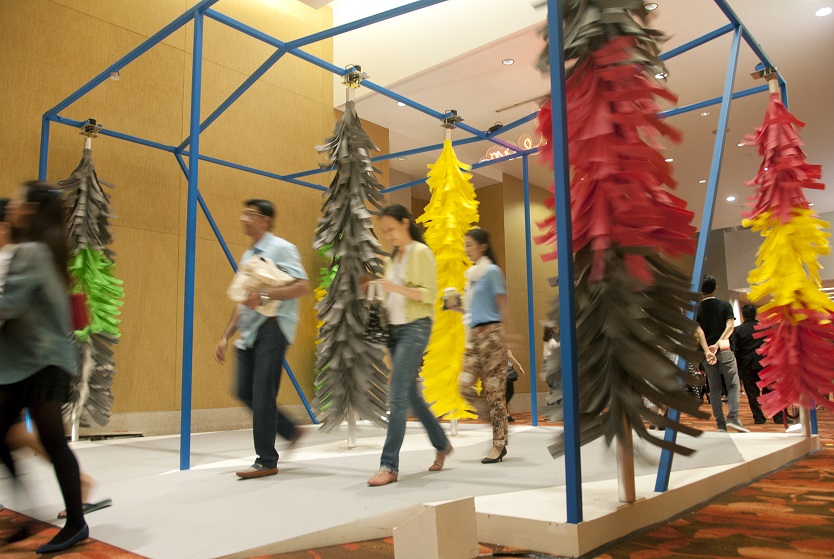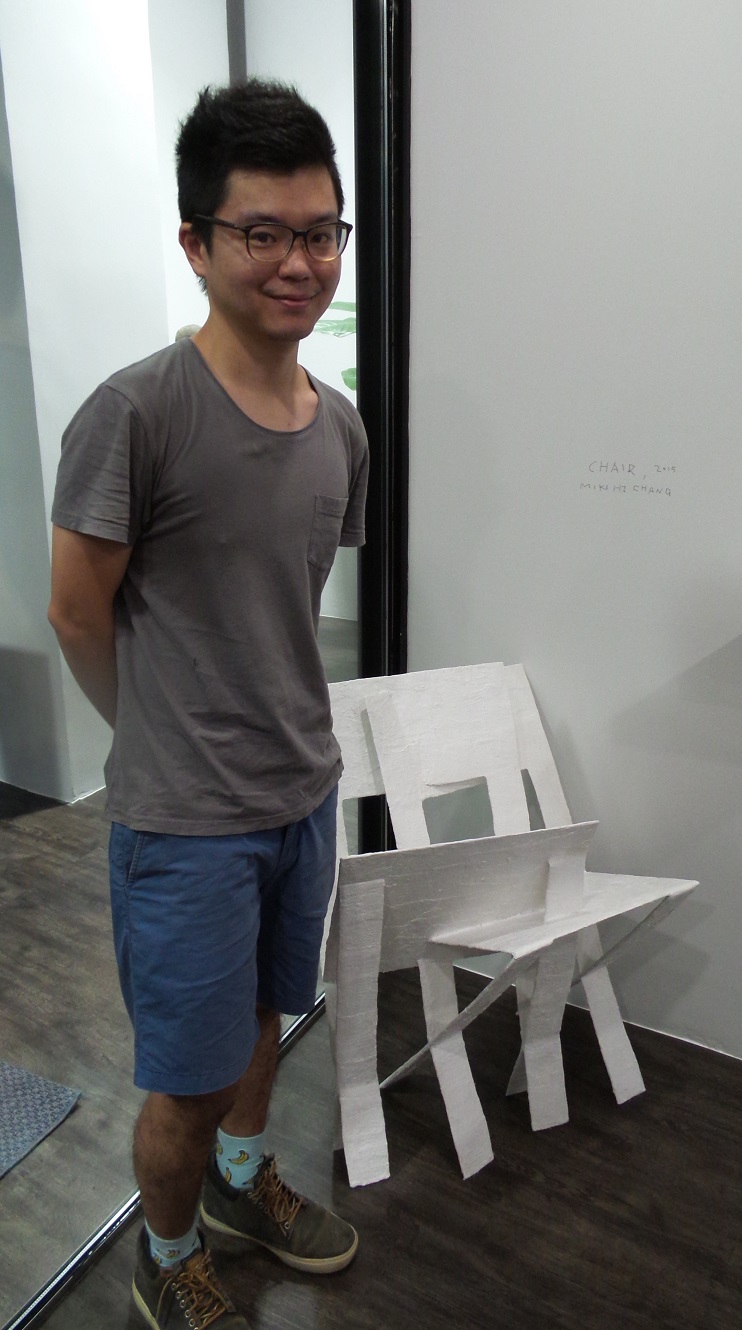Mike HJ Chang is a Taiwanese American artist and educator in the fine arts. After he graduated with BA from the University of California in 2005 and an MA from the California Institute of the Arts in 2008, Mike moved to Singapore, where he currently resides and works.
His works usually combine architecture, furniture and text to focus on the transient identity of spaces, where public and private intersect. He also explores the relationship between different states of existence through his works. Mike’s works are often well received with humour or at times, poignancy or self-righteousness. He has shown his work at Chan Hampe Galleries, Goodman Arts Centre, The Substation and Yeo Workshop.
Interview with Mike Chang
***
Nijvest (N): When did you arrive in Singapore and what are you up to here?
Mike (M): After graduation, I was looking for a place to go to in the South East Asia and eventually I found a teaching job in Singapore. Initially, it was not a long-term plan, but later I decided to stay here as I am able to work part-time while continuing my work in the arts. I also enjoy teaching arts here and since the first language is English, it is more comfortable for me. Singapore is also nearer to Taiwan where my family lives.
N: Your art is very much American-influenced. Do you find a different language (in arts) used in Singapore as opposed to the one you used in the States?
M: Yes, definitely. Although there is a mixture of artists here who use traditional South-East Asian art techniques and a number of contemporary artists who mainly studied in Europe or New York, not many people study the arts on the West Coast (of America), which has its own unique contemporary art history.
Humour, for one, is very different for me. What I find funny might not be so to the local artists, and vice versa. I also realised that the subject matter here is very different – they are focus on local history, collective memories or even subject matter that advocates certain values – this kind of art is too literal for me. Recently I prefer art that is quick, humourous and somewhat frivolous. I like to think about meaning, but as a viewer, I like to explore and discover the meaning behind art pieces, so I prefer the artists not to specifically spell out the meaning of their art work.
Another thing I have observed here is that people like to ask about artists’ intention and the meaning of the work. In the States, artists’ intentions are not the most important and everyone is free to think and make out their own perception of things. To me, I think meaning does not have to be delivered in such a literal way. As an artist, I try to express layers of meanings in an ambiguous way where viewers have to discover the meanings themselves.
N: Do you think that the local (Singapore) art scene is ready for that?
M: I think viewers in general are not ready for that. I am rather doubtful that the general public would actually sit down and think about art.
N: Do you think it is due to the culture?
M: I am not sure, but I feel that definitely people in the western countries are more willing to discuss art. This could be due to a country’s culture, its history, the local collectors, public collection, things that bring art forward in a society. Perhaps Singapore is still too young a country to have that kind of conducive environment.

(Above: Mike Chang’s installation “Car Wash” at the entrance of Art Stage Singapore 2015. Photo by Mike Chang.)
N: Tell us about your experience with “Car Wash”, the one you did for the Art Stage Singapore in 2015.
M: As a kid, I really enjoyed myself during car washes, so I thought it might be nice as an entrance (doorway) at the Art Stage Singapore. I have this idea of a metaphoric translation of unclean to clean – it signifies cleansing one’s mental state as they walk through the “Car Wash” from the outside into the inside. Actually, I have been thinking a lot about cleansing of our mental state. This concept comes from Lao Tzu, the Chinese philosopher, where he said “to attain knowledge, add things everyday; to attain wisdom, remove things everyday”. So, I thought the idea of a car wash fits very nicely as the entrance for Art Stage, which is fun and yet metaphorically means a cleansing of the guests’ mental state before they enter the art space.
N: How about your work here at Nijvest, “The Chair”? Could you share more with us about this piece?
M: It is a piece for an exhibition at Yeo Workshop, I was intrigued with the theme of private space. An artist’s studio is usually a private space where the artist produces his/her art work. At the same time, I want to use the mechanism of camera obscura as a metaphor to explore the relationship between the outside (world) and the inside (private). The outside world would enter as light projection into the interior via the pinhole. And if the pinhole is not cleaned cut or deformed, the projection would be distorted. In the case of the exhibition I punched two holes at the corner which are not perfectly round and overlapped each other. Conceptually, this would create a distorted projection, perhaps some sort of over lapping image. So following this line of thinking, I recreated my folding chair in the studio to make it to look like two identical chairs are existing in the same space and time, just a few degrees off. In a way, this chair piece is the manifestation of how the outside world enter into a private space.

(Above: Mike Chang posing with his work, “The Chair”, at Nijvest Asia. Photo by Nijvest.)
N: For the exhibition at Yeo Workshop, how did the collaboration come about?
M: The collaboration was built on discussions. For my first solo exhibition at the Yeo Workshop, Gallery Director, Audrey Yeo came to me one day and proposed to showcase my studio. She felt that it would be a good introduction of me as an artist to the market as I had always been active in private practice and commissioned works but never the collector’s market. I agreed with her proposal but thought it would be better to showcase an imprint of my studio rather than the actual thing. That is how the idea of a reconstruction of part of my studio through pinholes came about.
N: Has your stay in Singapore change your works, in particular, to being more Asian?
M: Well, formally I am a Taiwanese so my roots are still very much Asian. In fact, I like Mandarin pop songs, bands like Mayday (Wu Yue Tian), and at the same time, I am also very American-influenced. To me, I appreciate both American and Asian cultures as I feel that they are both part of me. I will continue to explore both cultures and see what the combination can bring to my works.
Though there is one thing I have taken an interest in during my stay in Singapore, and that is the notion of how a visitor, like myself, eventually becomes the host. The subtle transition in roles is very interesting. Therefore, you can see in a lot of my earlier works when I first came to Singapore, I put myself as the ‘visitor’ role and I explored the relationships between the ‘host’ and ‘visitor’ at intersections such as the doorway – how the ‘host’ welcomes you into their space; how the ‘visitor’ enters the space; how each role reacts and behaves knowing very well their own role in that particular space. I don’t think I will produce this kind of works if I were still in Taiwan or America.
N: Do you have a good environment of colleagues or partners who give you feedback about your works here?
M: Yes, definitely. It is a small art scene here in Singapore and it is quite competitive but, yes I have met many nice and friendly artists. There are many smart and committed people here and I felt very lucky to have met them.
N: Does current affairs affect any of your works?
M: I do not have any direct reference of current affairs in my works, but my thinking processes are being influenced by them. For example, there was a debate about population in Singapore a few years ago and it got me thinking about the relativity of space with the people who utilize them and how we could possibly understand a city through looking at the flexible and inflexible spaces.
N: What have you been busy with lately?
M: I am currently working on a series of prints for Grey Project, the title is “Covert Overt”. This project is limited edition prints and my assorted images of ten prints will include digital, silk-screen and woodblock prints using different mediums and materials. To align with the theme, I am thinking about what is inside the head and what is outside the head.
And right now I am working on putting together a group show at Yeo Workshop, which will happen in the coming June.
N: Are there any other things you would like to share with us?
M: Scale is something that I think about lately. So far my works are mainly built to human scale, so moving forward, I would like to see how I can produce more works that are off-human scale, an example is the “Car Wash”.
N: Thank you for your time today and we look forward to seeing your upcoming projects and works soon.
Share this Post

